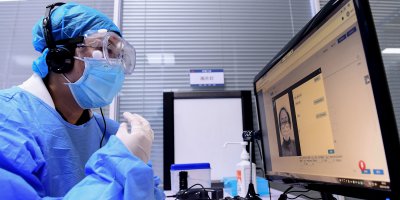
A 3D engineer working on a model in Italy. Source: Shutterstock
How 3D printing is helping with a medical supplies shortage
The healthcare industry is the most critically affected area since the start of the pandemic outbreak.
Having to cater to thousands of patients that need care and treatment for weeks-long has not only burdened medical facilities, but it has also shocked the entire healthcare ecosystem.
Aside from overcrowded hospitals, the industry is also suffering from a shortage of medical equipment and tools. From single-use face shields to safety goggles and emergency oxygen valves, the supplies are running low.
With quarantine orders being enforced in various parts of the globe and factories shutting down, the supply chain cannot possibly meet these demands as efficiently or quickly. To make up for the shortages, 3D-printer manufacturers have been coming forward offering to manufacture some of the equipment and even quarantine facilities.
Although medical equipment and tools generally require specific production procedures to ensure that they meet all the necessary industry standards, crowdsourced, 3D-printed ones seem to be doing the trick in these dire times.
China
The trend is believed to have started in Xianning, China where those needing quarantines did not have a place to stay. So, 3D printers were put into work to quickly construct ‘mini houses’ equipped with showers and toilets.
Additive manufacturer, Winsun, claimed to have printed out the walls of 15 of these mini houses in just a day using recyclable materials such as sand and construction rubble.
Jinhua, on the other hand, is tackling the shortage of safety goggles. Produced by an unnamed 3D-printing manufacturer, the goggles seal easier, don’t fog as much, and are lighter and more comfortable.
Not only were the goggles better, but the production was also quicker. The R&D team of the manufacturer got to work so fast that the designing and manufacturing took only 153 hours before they printed the goggles in large volume.
Malaysia
Very recently, in Malaysia, volunteers joined together to crowdsource 3D-printed face-shields. Given that the equipment is a single-use, disposable, personal protective equipment (PPE), supplies ran out rapidly.
Burdened front-liners then began requesting face-shields which were met with positive support by the citizens. A petition was then set up on Facebook to raise funds to support production costs.
Sixty-seven 3D-printers listed themselves as manufacturers for the project with the aim to produce up to 10,000 plastic face shields. Once some of them are printed out, these face shields will be sent for disinfection at a centralized point of collection.
Italy
In Italy, 100 emergency respiratory valves were manufactured by 3D printing company Issinova for a hospital in Brescia. All were produced in just 24 hours, the hospital was able to use these valves on patients for at most, 8 hours each.
The company’s mechanical engineer Alessandro Romaioli told BBC News that upon hearing the call for help, he and Cristian Fracassi, CEO, rushed to the hospital to get a look at the valves and came up with a prototype in just 3 hours.
“They tested it on a patient and they told us that it worked well and so we ran again back to our office and we started to print new valves,” said Romaioli.
Open-source projects have also been launched to support efforts from all over the world in the hopes of sourcing as many designers and manufacturers as possible to boost production. Most of these projects share a common goal of printing ventilators which are also in short supply.
If 3D printing can help the healthcare industry bear the strain on resources amid the coronavirus outbreak, it could pave the way for an increased of additive manufacturing for medical supplies in the coming years – particularly as the technology is advanced further.
READ MORE
- Ethical AI: The renewed importance of safeguarding data and customer privacy in Generative AI applications
- How Japan balances AI-driven opportunities with cybersecurity needs
- Deploying SASE: Benchmarking your approach
- Insurance everywhere all at once: the digital transformation of the APAC insurance industry
- Google parent Alphabet eyes HubSpot: A potential acquisition shaping the future of CRM


